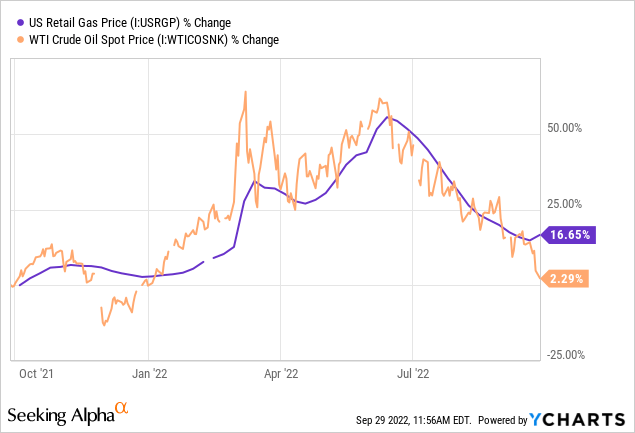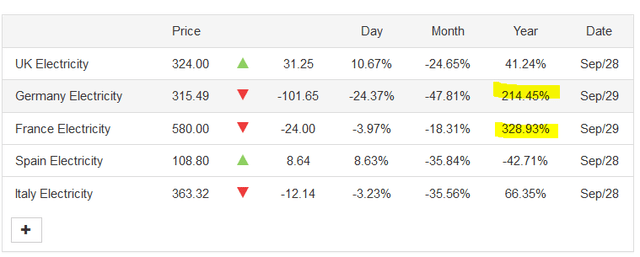aquaArts studio/iStock via Getty Images
Article Thesis
Tesla (NASDAQ:TSLA) is a leading electric vehicle manufacturer. The stock is priced for perfection, however, despite growing competition, rising costs for materials, and a global economic slowdown. On top of that, the ongoing global energy crisis is hurting Tesla in two ways, as I’ll explain in this article. Overall, that means that Tesla does not seem like an attractive pick at current prices, I believe.
The Globe Is Experiencing An Energy Crisis
The world’s hunger for energy continues to grow, as it has for many years. At the same time, ESG mandates and regulatory pressures have led to underinvestment in (fossil) energy production, which has resulted in a tight supply-demand situation. On top of that, the ongoing Russia-Ukraine war has exacerbated issues in global energy markets. That has led to exploding energy prices across all kinds of commodities. Rising gasoline prices have gotten a lot of attention, but price increases were even more pronounced in other areas:

WTI is up by just a couple of percentage points over the last year, while gasoline has become 17% more expensive over the last twelve months. Especially in Europe and Asia, price increases of non-oil-based energy products have been way more drastic.
Natural gas prices in Europe, for example, have exploded upwards by more than 1,000% over the last two years:
Contracts rose from $15 two years ago to more than $200 today, dwarfing the increase in oil prices. Natural gas in Asia, e.g. measured by JKM, has become incredibly more expensive as well. Likewise, electricity has become way more expensive in Europe — driven, to a large degree, by the huge increase in natural gas prices:
Market prices (day-ahead) for electricity soared by several hundred percentage points over the last year in leading European countries such as Germany and France. Price increases for forward months have been even higher, e.g. for the coming winter months. Baseload prices for Q1 2023 are north of €500 per MWh in Germany, for example. Peak-load prices for the same quarter are even higher, at close to €800 per MWh.
In many other markets around the world, electricity is scarce and has become very expensive as well. China is of note, for example. Weather anomalies in the country have led to below-average power generation from hydro, which has led to shortages and steep price increases.
Overall, we can summarize that energy has become way more expensive in many areas of the world. Oil prices and gasoline prices get a lot of attention, but they have actually not moved up much versus the massive increases by hundreds of percentage points we have seen in electricity, natural gas, and even thermal coal — which is up 350% over the last five years. Why does this matter for Tesla? Let’s delve into the details.
Impact On Tesla: Items To Consider
So why does it matter that the global energy crisis has led to massive increases in the price of natural gas, electricity, etc. when it comes to an investment in TSLA stock? There are several negative impacts this will have on Tesla, I believe. Some of those are Tesla-specific, others impact other automobile companies as well.
Free Supercharger
First, Tesla will lose more money with the free supercharger for life deal it offered in the past. With electricity costs soaring, those that can charge for free at superchargers will be more inclined to do so. This will mean that Tesla will have to offer more electricity for free. At the same time, that electricity comes at a higher cost for Tesla, as market prices for electricity have soared in important end markets. Overall, this means that Tesla will lose more money on its supercharger-for-life deals than previously thought.
EVs Lose Their Cost Advantage
For a long time, EVs were touted as cheaper than ICE-powered vehicles when it comes to fuel costs. But due to the massive increase in electricity prices, relative to the way more benign increase in gasoline prices, that does no longer hold true. Let’s look at an example.
The Tesla Model 3 uses 17 kWh per 100 km. A comparable ICE car, such as the BMW 3 series (OTCPK:BMWYY), uses around 5.0 liters of diesel for the same 100 km. When electricity prices were way lower than they are right now, that made for a clear cost advantage for Tesla. But more recently, that’s no longer true — at least not in all markets. Tesla currently sells electricity for €0.70 per kWh at its superchargers in Germany, where it recently opened one of its Gigafactories, making this an important market for Tesla. That means that driving a Model 3 for 100 km results in fuel expenses of €11.90, or around $11.50. Diesel currently costs €1.98 per liter in Germany on average. The BMW 3 series thus uses €9.90, or $9.60 per 100 km. Using an ICE-powered BMW that is comparable to Tesla’s EV thus costs around 20% less in fuel expenses today in Germany. The former cost advantage for EVs has turned into a cost disadvantage in Europe’s biggest market and one where Tesla thought it had a lot of potential — otherwise, it wouldn’t have built a Gigafactory there. In other European countries, things are looking comparable. In the UK, for example, the diesel-powered BMW 3 costs around $10 per 100 km, while the Tesla Model 3 costs around $11 per 100 km.
This means that one of the key arguments for buying an EV, lower fuel costs, is no longer valid, at least in some of Tesla’s markets. In the US, where electricity cost per kWh differs very much from state to state, there are some markets where EVs are still cheaper to fuel. But even in the US, some markets are more favorable for ICE vehicles right now, such as California with its high electricity prices. With this key argument for switching to an EV gone, EV manufacturers such as Tesla could have a harder time convincing consumers to make the switch. Many consumers, especially those that feel the pinch from the current economic slowdown, will ask themselves why they should buy a new vehicle for many thousands of dollars just to have their fuel expenses go up.
Higher Production Costs
The process of manufacturing batteries is highly energy intensive. That energy usually does not come in the form of oil (which has gone up in price only slightly), but typically in the form of electricity — which has gotten way more expensive. Battery manufacturing thus is feeling a considerable cost headwind in the current environment, and the biggest battery users in the world, such as Tesla, will likely feel the largest impact.
In Europe and China, energy-intensive manufacturing is oftentimes either unprofitable or forced to scale back due to regulatory demands to conserve energy. This will hinder Tesla’s Gigafactories in Germany and China, making it quite exposed to electricity/energy shortages around the world. EV companies with less exposure to Europe and China, such as Ford with its US focus, could be more advantaged in the current environment, as energy shortages are less pronounced in the United States.
Cash-Strapped Consumers Might Keep Their Cars Longer
With energy prices soaring, especially in Europe, consumer sentiment is falling off a cliff. Consumers have to spend more on essentials such as electricity, heating, and food, which means that they have less money left over for non-essential, discretionary consumer goods.
Ultra-high-end manufacturers such as Ferrari (RACE) will likely feel less of an impact, as middle-class households don’t buy Ferraris anyway and as very wealthy consumers don’t feel much of a pinch from higher energy costs. But Tesla, along with competitors such as BMW or Audi, could feel an impact from middle class/upper middle class consumers becoming more frugal. When essential expenses are soaring, and when the risk of a job loss increases due to the ongoing economic downturn, many consumers will be more reluctant to acquire a costly new vehicle. One can argue that this is already being reflected by the declining wait times for many of Tesla’s models in China, which is experiencing many of the same headwinds as Europe — growing energy costs and an economic slowdown.
Summing Things Up
Tesla is a leading EV company. Depending on whether one counts plug-in hybrids or not, it’s either the largest or second-largest EV manufacturer in the world. But the company is highly expensive, trading at well above 60x forward earnings, while traditional auto peers such as Mercedes (OTCPK:MBGYY) trade at less than 5x forward profits. Competition is growing, input costs are rising quickly, and consumer discretionary companies including Tesla are highly exposed to a global economic downturn.
Add the above issues stemming from the global energy shortage, such as waning advantages for EVs due to high charging costs and Tesla’s growing costs for its supercharger-for-life deals, and it does not look like Tesla is a good buy today. Last but not least, rising interest rates are pressuring all equities, but have the largest impact on long-duration stocks such as Tesla. Overall, I see more reasons to be bearish than to be bullish right here, which is why I think Tesla is an avoid today, although I have no intention of going short the stock.




Be the first to comment